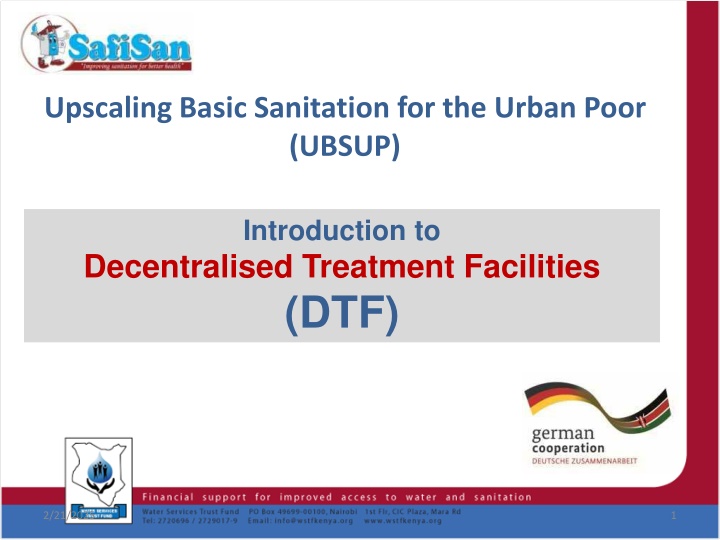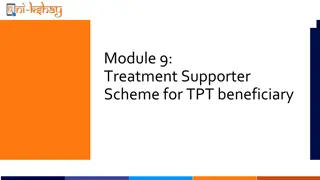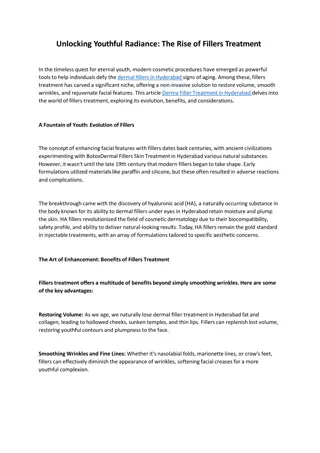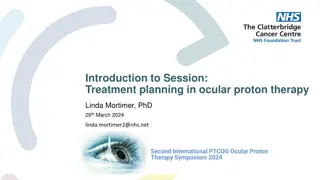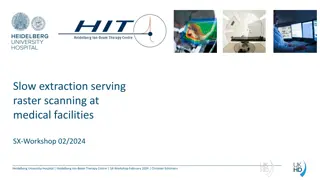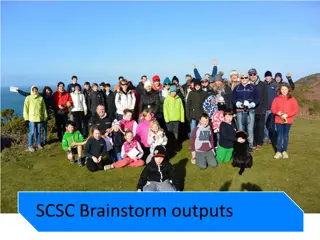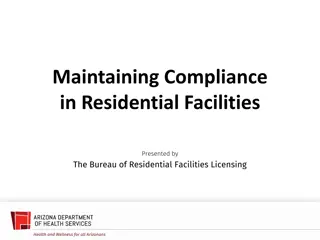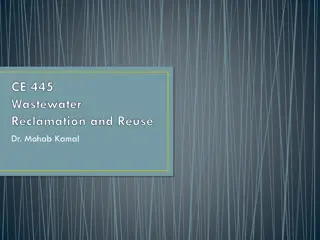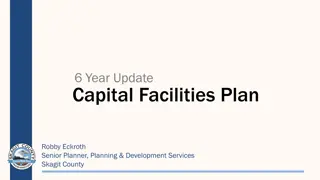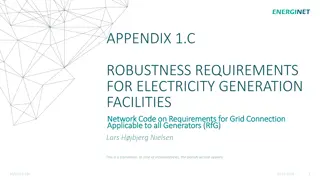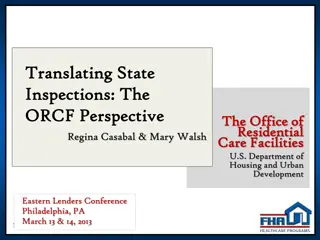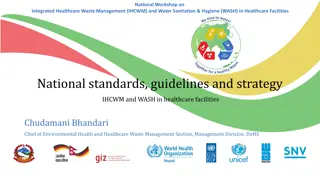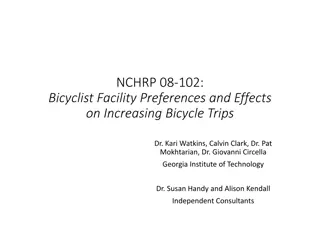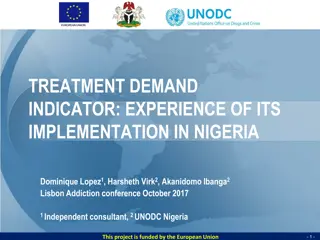Introduction to Decentralised Treatment Facilities
This session introduces the concept of Decentralised Treatment Facilities (DTF) and explores the reasons behind the need for DTF in addressing environmental pollution and public health problems related to improper sanitation practices. The content covers the design, operation, and importance of DTF in safe disposal and reuse of faecal sludge in urban areas. Discussions include the benefits of decentralised treatment and the challenges posed by traditional sanitation methods.
Download Presentation

Please find below an Image/Link to download the presentation.
The content on the website is provided AS IS for your information and personal use only. It may not be sold, licensed, or shared on other websites without obtaining consent from the author.If you encounter any issues during the download, it is possible that the publisher has removed the file from their server.
You are allowed to download the files provided on this website for personal or commercial use, subject to the condition that they are used lawfully. All files are the property of their respective owners.
The content on the website is provided AS IS for your information and personal use only. It may not be sold, licensed, or shared on other websites without obtaining consent from the author.
E N D
Presentation Transcript
Upscaling Basic Sanitation for the Urban Poor (UBSUP) Introduction to Decentralised Treatment Facilities (DTF) 2/21/2025 1
Objective: To make you understand the DTF concept 2/21/2025 2
Content Questions you might to ask yourself: What is the context of this session? Why do we need a DTF? What is treated? ... and why decentralised? Where do we need a DTF? How does a DTF work... and how is it designed? How do we design our DTF? Can I see, touch and smell one? 2/21/2025 3
What is the context of this session? The SafiSan Toolkit Training to be provided Training to be provided Training to be provided 2/21/2025 4
What is the context of this session? The SafiSan Toolkit Spit into two training sessions: Now: DTF Introduction, Site Selection & Surveying Later: DTF Design Adaptation 2/21/2025 5
What is the context of this session? The SafiSan Toolkit All information can be found in your manual 2/21/2025 6
Why do we need a DTF? Your Company has applied for a DTF to be financed by the WSTF WHY? Group exercise Your DTF : Please discuss within your DTF Technical Team for 10 minutes why you proposed a DTF Please explain then 5 minutes to the plenary why you need a DTF within your service area 2/21/2025 7
Why do we need a DTF? Environmental Pollution Public Health Problems UDDT: matter does often not comply with required standards due to improper use collected excreta are still wet and not completely stabilised safe disposal and reuse not possible This also refers to faecal sludge (FS)removed by exhausters / manually from septic tanks or latrines Septic tanks: incomplete treatment (only primary treatment) safe disposal/reuse of faecal sludge is not possible Latrines: emptied human excreta contains all kinds of pollutants requires further treatment 2/21/2025 8
Why do we need a DTF? Environmental Pollution Public Health Problems So a DTF intends to close the Sanitation Value Chain by allowing for: Adequate treatment of FS / waste water (WW) / UDDT matter Safe disposal of treated effluent to the environment Reuse of water for irrigation Reuse of dried sludge as soil conditioner Reuse of compost as fertiliser 2/21/2025 9
Why do we need a DTF? Environmental Pollution Public Health Problems Access to Adequate Sanitation for residents of Urban Low Income Areas (LIAs) 2/21/2025 10
What is treated? A DTF treats human excreta produced in urban LIAs Faecal Sludge (FS) removed by exhauster trucks from septic tanks or manually from latrines (Partly) dried organic matter from UDDTs Wastewater (WW) generated in Toilets/latrines and conveyed through a (simplified) sewer system (to be approved by WSTF) 2/21/2025 11
What is NOT treated? Never to be treated are: X Greywater (from laundry, kitchen, etc.) due to low pollution loads that would negatively affect the treatment performance of the DTF X Storm water as even co-treatment is not beneficial as the treatment capacity of the DTF must then be much higher 2/21/2025 12
What is treated? Various waste streams to be treated (or not): 2/21/2025 13
Why decentralised treatment? 3 not suitable treatment concepts: Left: only low sewer coverage in Kenya LIAs and peri-urban areas remain usually uncovered due to other priorities Centre: full coverage is technically demanding and expensive a rather theoretical approach not state of the art / beneficial Right: full coverage of urban area is not feasible due to restricted land availability in urban centres & high total investment cost 2/21/2025 14
Why decentralised treatment? Most suitable treatment concept: Connecting core city areas (i.e. high income areas) to a centralised system and serving omitted areas (i.e. LIAs) locally with DTFs DTFs supplement centralised treatment Both treatment concept must go hand in hand 2/21/2025 15
Why decentralised treatment? Advantages Sanitation Concept Centralised treatment Restrictions Convenient No user involvement required Hygienic and safe as no contact with human excreta Proven and accepted technology Fresh water used for transport Often pumping required (high energy needs and costs) Continuous O&M of sewer High-tech systems (high investment and running costs) No reuse of water and nutrients Mind-set of people favours centralised systems Limited know-how available (design, construction, O&M) Little public awareness Less convenient High range of technologies (incl. close-to- nature systems), often without electricity Low investment costs (no or only simplified sewer needed) No mixing with grey- and rainwater (smaller volume) Less water wastage (transport) High public health outcome (coverage) Source-separated treatment possible High potential for local reuse of water, nutrients and energy Decentralised treatment 2/21/2025 16
Where do we need a DTF? A DTF is required to: Treat human excreta (FS, UDDT matter) generated in a nearby urban LIA Enhance public health conditions in a project area Close the sanitation value chain by reutilising compost, soil conditioner, irrigation water in a safe manner Ensures small per capita investment Treatment of FS / UDDT waste is preferred over treatment of WW conveyed through an expensive sewer system 2/21/2025 17
Where do we need a DTF? Typical area of application for a DTF: 2/21/2025 18
How does a DTF work: in general? A DTF project follows several transport, treatment and reuse lines: generation & pre-treatment transport to the DTF treatment in a DTF reuse 2/21/2025 19
How does a DTF work? A DTF consists of various parallel and sequenced treatment lines: Receiving Bay & Balancing Tank mechanical preliminary treatment 2/21/2025 20
How does a DTF work? A DTF consists of various parallel and sequenced treatment lines: Settler mechanical primary treatment 2/21/2025 21
How does a DTF work? A DTF consists of various parallel and sequenced treatment lines: Anaerobic Baffled Reactor anaerobic secondary treatment 2/21/2025 22
How does a DTF work? A DTF consists of various parallel and sequenced treatment lines: Vertical Flow Constructed Wetland aerobic tertiary treatment 2/21/2025 23
How does a DTF work? A DTF consists of various parallel and sequenced treatment lines: Sludge Drying Reed Bed parallel treatment of ST/ABR sludge 2/21/2025 24
How does a DTF work? A DTF consists of various parallel and sequenced treatment lines: Co-composting Area parallel treatment of UDDT matter, organic waste (and dried sludge) 2/21/2025 25
How does a DTF work: treatment stages The treatment process inside a DTF can be distinguished: Into treatment stages... Preliminary Treatment Primary Treatment Secondary Treatment Tertiary Treatment Sludge Treatment Anaerobic Baffled Reactor Sludge Drying Reed Bed / Co-composting Area Receiving Bay / Balancing Tank Vertical Flow Constructed Wetland Settler 2/21/2025 26
How does a DTF work: treatment forms The treatment process inside a DTF can be distinguished: ... and into treatment forms Receiving Bay / Balancing Tank Settler Anaerobic Baffled Reactor Vertical Flow Constructed Wetland Sludge Drying Reed Bed / Co-composting Area RB/BT (Screen) ST VFCW ABR SDRB / CA 2/21/2025 27
How does a RB/BT look like? Receiving Bay and Balancing Tank: preliminary treatment/storage 2/21/2025 28
How does a RB/BT work? Unload two exhausters at same time Screening of FS/WW to remove solid waste Regulated discharge to the settler Overflow to settler 2/21/2025 29
How is a RB/BT designed? Storage of FS/WW for up to 24 hours Tank volume depends on FS/WW inflow and regulated discharge into settler during hours of operation (e.g. 12h/d) 2/21/2025 30
How does a ST look like? Settler: primary treatment of FS/WW 2/21/2025 31
How does a ST look like? Settler: primary treatment of FS/WW 2/21/2025 32
How does a ST work? Mechanical treatment Sedimentation and floatation of (mainly) inorganic solids Scum layer accumulating on the surface (fat, grease, hair, plastics, needs) to be removed regularly Sludge accumulating at the bottom needs to be removed regularly Treatment efficiency is in the range of 25% - 40% removal of organic pollution Pathogens and nutrients are barely removed 2/21/2025 33
How is a ST designed? Hydraulic retention time: 2 days to allow for sufficient sedimentation of (inorganic) solids Sludge storage volume: approx. 50% of water volume Water depth: 2.5m (level at outlet pipe) Length-width ratio: 3:1 to 2:1 (split into two compartments of 2:1) Inlet-outlet level difference: 0.1m to ensure hydraulic gradient 2/21/2025 34
How does a ABR look like? Anaerobic Baffled Reactor: secondary treatment of FS/WW 2/21/2025 35
How does a ABR look like? Anaerobic Baffled Reactor: secondary treatment of FS/WW 2/21/2025 36
How does a ABR work? Consist of approx. 6 chambers A parallel series of pipes direct FS/WW from top to bottom FS/WW passes through sludge whereby it is mixed with organisms that decompose pollutants Settled sludge must be removed in regular intervals; some sludge must be left for continuous efficiency Efficiency increases with higher organic load (65% - 95% BOD removal); pathogen reduction is 40-75% 2/21/2025 37
How is a ABR designed? Up-flow velocity in chambers: <1m/h to avoid flushing out of bacteria Hydraulic retention time: >12 h to ensure biological degradation 5-6 chambers (D=1.85m, L=0.7m) Inlet-outlet level difference: 0.1-0.15m to ensure hydraulic gradient 2/21/2025 38
How does a VFCW look like? Vertical Flow Constructed Wetland: tertiary treatment FS/WW 2/21/2025 39
How does a VFCW look like? Vertical Flow Constructed Wetland: tertiary treatment FS/WW 2/21/2025 40
How does a VFCW work? Pre-treated FS/WW is dosed intermittently onto filter planted with reed Roots grow into the filter media, bringing oxygen to the root zone During a flush phase, water percolates down and is filtered by gravel Nutrients and organic material are absorbed and degraded by bacteria attached to gravel and roots Pathogens are removed by natural die-off, predation by higher organisms, and sedimentation A drainage network at the base collects the effluent 2/21/2025 41
How is a VFCW designed? Organic load: <30 g BOD/ m /day to avoid organic overload and to ensure biological degradation Number of areas of alternating use: 2 to ensure aerobic conditions Height of filter material: 0.8m (layers of gravel of diameter 4/8 and 8/16) Feeding network on surface, drainage pipes on base (base with 1% slope) 2/21/2025 42
How does a SDRB look like? Sludge Drying Reed Bed: treatment of sludge from ST and ABR 2/21/2025 43
How does a SDRB look like? Sludge Drying Reed Bed: treatment of sludge from ST and ABR 2/21/2025 44
How does a SDRB work? Filled with gravel to support the vegetation on top Sludge is applied to surface and filtrate is collected in drain Fresh sludge is applied directly onto the previous layer as roots maintain the porosity of the filter media Various compartments are charged alternating to allow for drying Decreases sludge volume to 50% through decomposition and drying Ideally coupled with co-composting area 2/21/2025 45
How is a SDRB designed? Sludge generation: 0.0037 l/g BOD5 removed (in ST and ABR) Application rate: 0.1 m /m *month Height of filter material: 0.75m (0.2-0-6mm sand, 7-15mm gravel, 15-30mm rock) 2/21/2025 46
How does a CA look like? Co-composting Area: treatment of UDDT matter, organic waste, sludge 2/21/2025 47
How does a CA look like? Co-composting Area: treatment of UDDT matter, organic waste, sludge 2/21/2025 48
How does a CA work? A ratio of 1:2 to 1:3 between dewatered sludge/UDDT matter and organic waste is mixed Mixed material is piled into long heaps (windrows) and left to decompose for approx. 3 months Windrows are turned periodically to provide oxygen and ensure that all parts of the pile are subjected to the same heat treatment Piles should be insulated with compost or soil to promote an even distribution of heat Careful planning and design required to avoid failure 2/21/2025 49
How is a CA designed? Max. height of compost windrows: 1.2 m Max. width of compost windrows: 2.5 m Composting time: 3 months The facility should be roofed to prevent excess evaporation (sunlight) and protection from rain 2/21/2025 50
